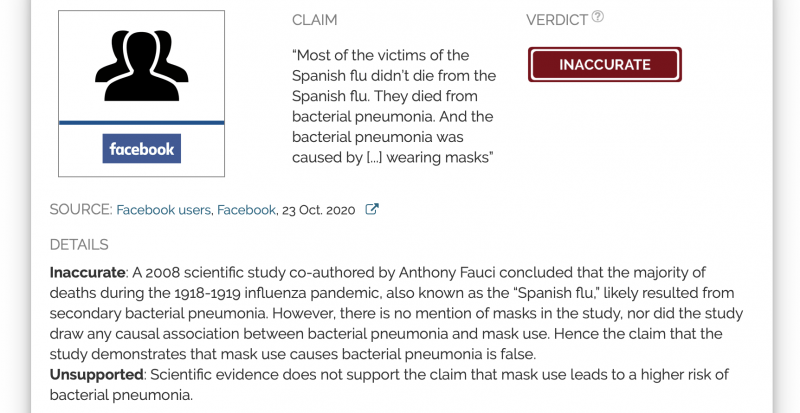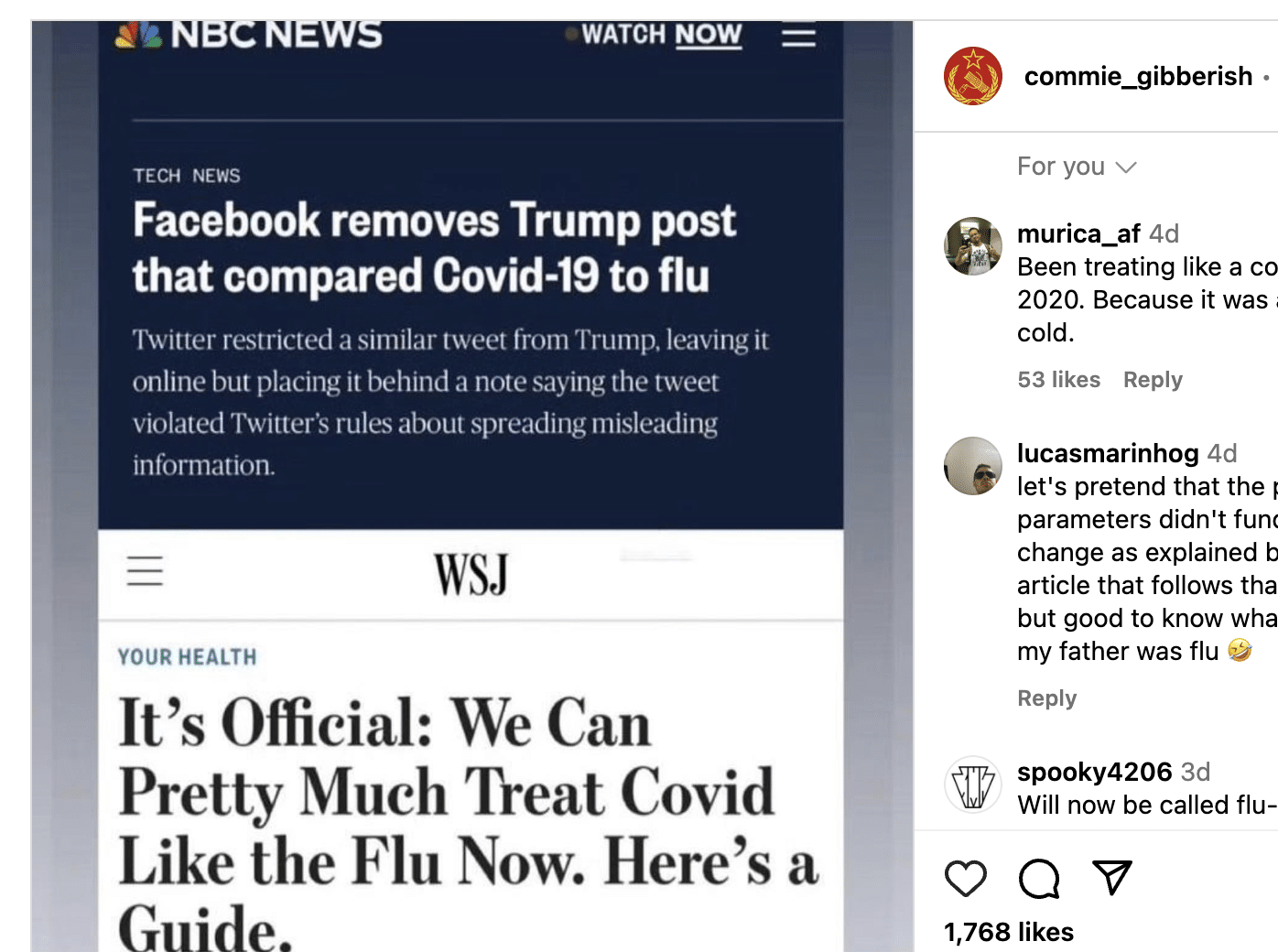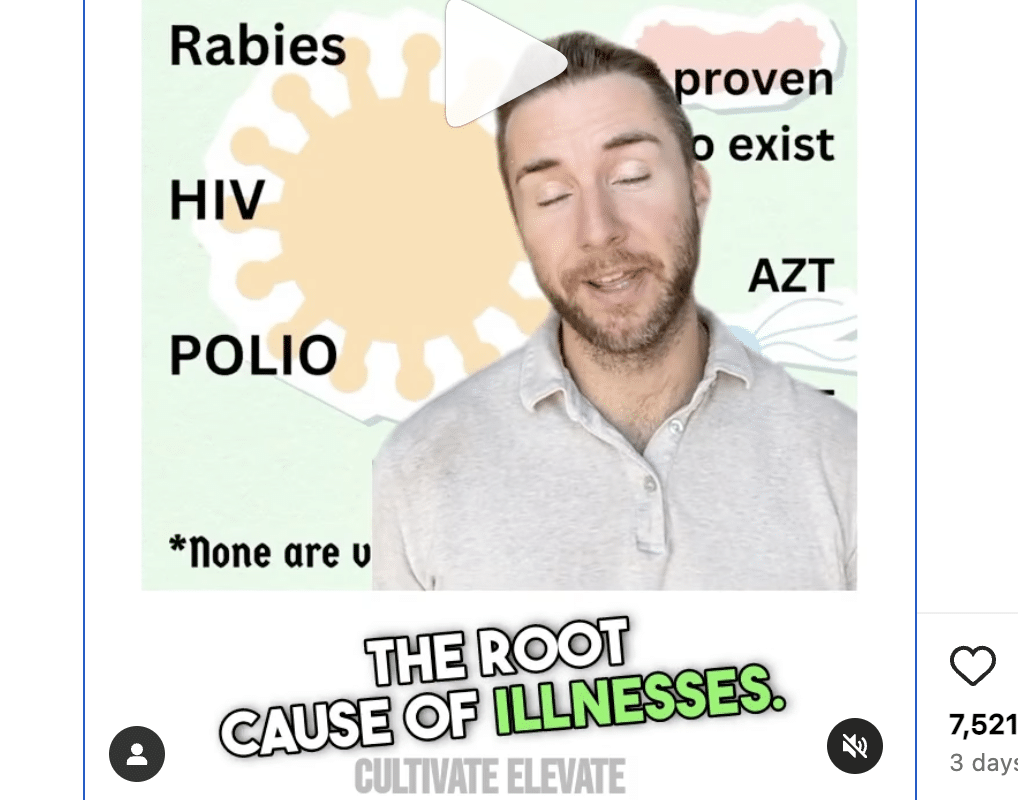- Health
A 2008 study co-authored by Anthony Fauci did not find that masks caused bacterial pneumonia, contrary to viral social media claim
Key takeaway
Scientific studies have associated flu with a higher risk of secondary infection with other viruses and bacteria. Face masks are effective at reducing the spread of viral respiratory infections like COVID-19 and the flu. Face masks are safe to use and not associated with an increased risk of bacterial pneumonia or other health problems.
Reviewed content

Verdict:
Claim:
“Most of the victims of the Spanish flu didn’t die from the Spanish flu. They died from bacterial pneumonia. And the bacterial pneumonia was caused by [...] wearing masks”
Verdict detail
Inaccurate: A 2008 scientific study co-authored by Anthony Fauci concluded that the majority of deaths during the 1918-1919 influenza pandemic, also known as the “Spanish flu,” likely resulted from secondary bacterial pneumonia. However, there is no mention of masks in the study, nor did the study draw any causal association between bacterial pneumonia and mask use. Hence the claim that the study demonstrates that mask use causes bacterial pneumonia is false.
Unsupported: Scientific evidence does not support the claim that mask use leads to a higher risk of bacterial pneumonia.
Full Claim
“In 2008, Dr. Anthony Fauci co-authored a paper about the Spanish flu […] They discovered that most of the victims of the Spanish flu didn’t die from the Spanish flu. They died from bacterial pneumonia. And the bacterial pneumonia was caused by… wait for it, wait for it…. wearing masks.”
Review
Misinformation about mask use has circulated since the beginning of the COVID-19 pandemic. Claims that wearing face masks increase the risk of infection are not new and were previously found to be inaccurate, as reported in Health Feedback reviews here and here. In October 2020, numerous social media posts on Facebook and Twitter claimed that the majority of “Spanish flu” deaths were due to bacterial pneumonia caused by wearing masks. The claim is based on a 2008 study published in the Journal of Infectious Diseases and co-authored by Anthony Fauci, director of the U.S. National Institute of Allergy and Infectious Diseases[1].
The 2008 study examined the causes of death for patients who died during the 1918-1919 flu pandemic, with the aim of improving future flu pandemic responses. It found that, “The majority of deaths in the 1918-1919 influenza pandemic likely resulted directly from secondary bacterial pneumonia caused by common upper respiratory-tract bacteria.”
Given this finding, the study proposed that, “pandemic planning needs to go beyond addressing the viral cause alone (e.g., influenza vaccines and antiviral drugs). Prevention, diagnosis, prophylaxis, and treatment of secondary bacterial pneumonia, as well as stockpiling of antibiotics and bacterial vaccines, should also be high priorities for pandemic planning.”
These findings are supported by numerous other studies that found that flu is associated with secondary infections from other viruses and bacteria, including bacterial pneumonia[2-6]. However, the 2008 study as well as these other studies do not mention mask use or that masks cause bacterial pneumonia.
Multiple experts debunked the claim that masks cause bacterial pneumonia. Davidson Hamer, a professor of global health and medicine at Boston University stated, “There’s no evidence of masks leading to fungal or bacterial infections of the upper airway or the lower airway as in pneumonia.”
Catharine Paules, an assistant professor at Pennsylvania State University and specialist in infectious diseases, also pointed out that there is no data to support the claim, “Masks trap in bacteria and fungus and make people more susceptible to bacterial or fungal pneumonia.” Taison Bell, an assistant professor at the University of Virginia who specializes in critical care and infectious diseases, stated that no association between bacterial pneumonia and mask use has been observed in any reputable study so far.
In summary, the claim that the 2008 study by Fauci and co-authors observed a causal link between deaths from the Spanish flu due to bacterial pneumonia and the use of face masks is inaccurate. The study makes no mention of masks, and no scientific study to date establishes a causal association between mask use and increased risk of bacterial pneumonia in the general population.
REFERENCES
- 1 – Morens et al. (2008) Predominant role of bacterial pneumonia as a cause of death in pandemic influenza: implications for pandemic influenza preparedness. Journal of Infectious Diseases.
- 2 – Smith and McCullers. (2014) Secondary bacterial infections in influenza virus infection pathogenesis. Current Topics in Microbiology and Immunology.
- 3 – Morris et al. (2017) Secondary bacterial infections associated with influenza pandemics. Frontiers in Microbiology.
- 4 – Van der Sluijs et al. (2010) Bench-to-bedside review: Bacterial pneumonia with influenza – pathogenesis and clinical implications. Critical Care.
- 5 – Metersky et al. (2012) Epidemiology, microbiology, and treatment considerations for bacterial pneumonia complicating influenza. International Journal of Infectious Diseases.
- 6 – MacIntyre et al. (2018) The role of pneumonia and secondary bacterial infection in fatal and serious outcomes of pandemic influenza a(H1N1)pdm09. BMC Infectious Diseases.



